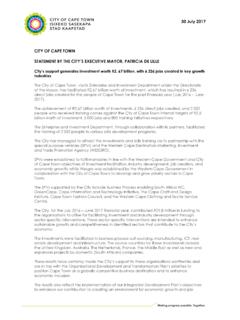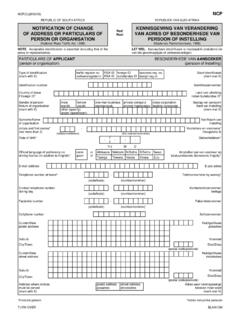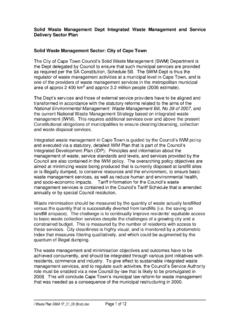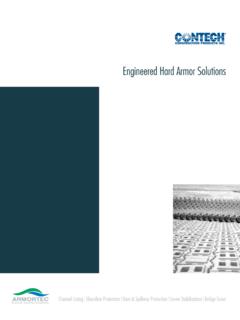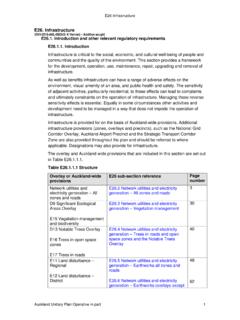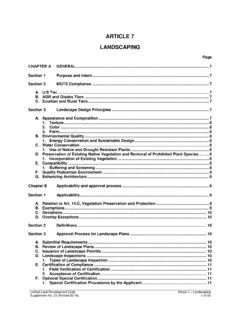Transcription of Change has occurred - Cape Town
1 The NEW. Heritage protection overlay Zone (HPOZ). Since 1 March 2013 areas previously protected as Conservation/Special Areas under the old Zoning Schemes are now protected as Heritage protection Overlays under the new integrated Cape Town Zoning Scheme. Change has occurred With the implementation of the new integrated Cape Town Zoning Scheme the new HPOZs have come into place taking over from previous conservation areas and special areas. The immediate changes however are not extensive in the transition from conservation areas and special areas to Heritage protection Overlays. The Heritage Resources Section (HRS) of the City's Environmental Resource Management Branch continues to manage heritage resources under LUPO but in terms of the HPOZ established through the new Cape Town Zoning Scheme.
2 Remember the HPOZ must currently be read together with the Exemption 3 in the appendix. Administration should continue as before, other than for slighter stronger control over alterations externally visible alterations, Change in use and excavations. We are bound to face some challenges as we cut our teeth on the new system we shall try to address queries immediately. We shall also be keeping a list of additional amendments that may be required to the zoning scheme heritage component. Please forward any heritage HPOZ queries, or suggestions to Why this Change It has been for a long time necessary for the City to integrate the many different zoning schemes inherited from the smaller municipalities when the metro was formed.
3 With the development of this new integrated zoning scheme, the National Heritage Resources Act stipulates that certain heritage protections included in the Act must be carried through into the zoning scheme. The Heritage protection overlay Zone has been drawn up to conform to the requirements for the heritage components of zoning schemes required under the NHRA in terms of both Heritage Areas (Section 31) and the Register (Section 30). As these sections of the NHRA are more stringent than the protections under the previous conservation areas, a default exemption (Exemption 3) from requiring approval for certain activities (within previous conservation areas) has been published.
4 1. This generally brings the HPOZ protections over previous conservation areas in line with their previous protections under the old zoning schemes. As such the status quo . will in practise remain largely unchanged. This general default exemption level for pervious conservation areas will be reviewed for individual properties at the time of re-assessment of the grading and significances of these properties in the future. In terms of the new Cape Town Zoning Scheme, previous conservation areas are protected as the Heritage protection Overlays. The names of these individual areas have not changed. For example the old Chapel Street Conservation Area is now the Chapel Street Heritage overlay .
5 Previous Conservation (or equivalent) Areas now protected under the HPOZ. Mowbray Station HPO/1/1 21. Mowbray Rosebank HPO/1/1 22. Little Mowbray HPO/1/1 23. Upper Rondebosch HPO/1/2 24. Belmont Road, Rondebosch HPO/1/2 25. Silwood, Rondebosch HPO/1/3 26. St Michael's, Rondebosch HPO/1/4 27. Lower Rouwkoop Road, Rondebosch HPO/1/4 28. Westerford, Rondebosch HPO/1/4 29. Kelvin, Rondebosch HPO/1/4 30. Wynberg Village HPO/1/5 31. Muizenberg Village HPO/1/6 32. Atlantic / Beach Road, Muizenberg HPO/1/6 33. Royal / Beach Road, Muizenberg HPO/1/6 34. Muizenberg-St James-Kalk Bay HPO/1/7 35. Simon's Town Special Architectural Area HPO/1/8 36.
6 Sea Point, St Bedes and Green Point HPO/2/1 1, 2, 3. Loader Street HPO/2/2 4. Central City HPO/2/3 5. Wandel Street HPO/2/3 6. Maynard Street HPO/2/3 7. Upper Table Valley HPO/2/4 8. Upper Table Valley (Vredehoek) HPO/2/5 9. Chapel Street HPO/2/6 10. Victoria Road HPO/2/6 11. Queens Road HPO/2/6 12. Chester / Coronation Street HPO/2/6 13. Roodebloem Road HPO/2/6 14. Albert Road HPO/2/7 15. Cavendish Square HPO/2/7 16. Regent Street HPO/2/7 17. Salt River HPO/2/7 18. Upper Observatory HPO/2/8 19. Lower Observatory HPO/2/8 20. Pinelands HPO/2/9 21. 2. It must be noted that Clifton-Bakoven are already deemed heritage areas in terms of the transitional arrangement of the NHRA, and are governed by their by-law.
7 They are also special Local Areas ( overlay Zones) in terms of the new CTZS. What activities currently require City Heritage approval In terms of the HPOZ? The protections in terms of the HPOZ read with Exemption 3 which has been applied to old conservation areas are currently similar to their previous protections. It should be noted that approvals required under the HPOZ for physical alterations are limited to external changes or other changes that could affect the way a place appears or is used. Approval for excavation below ground is also required. This may Change at a later stage as delegations and lifting of the 60 years clause takes place and sites are individually assessed as to applicable exemptions in accordance with grading and significances.
8 Activity Requiring HPOZ Approval in Example an HPOZ area with Exemption 3. Any addition of any new structure Construction of new buildings, walls, car ports, signage posts etc Any external alteration to a place or Additions to buildings structure Replacement of shop fronts Change of roof type Addition of roof lights Extension of pavements etc Any development that may influence its Removal of internal walls that may make stability and future well-being a structure unsafe etc Changes to or removal of any external Replacement of old windows and doors fittings or joinery which has been in situ for etc more than 60 years Any internal alteration that is visible from Building floor levels across windows in a outside a building building being converted to a parking
9 Garage Painting of any natural finishes on the Painting a sandstone building exterior of a structure Painting a teak shop front window Subdivision or consolidation Subdivision or consolidation Any Change to the natural or existing Flattening or building up or changing topography of land levels of a landscape Any removal or destruction of trees, Cutting down a gum tree over 60 years mature plantings or hedges or changes to old a historical landscape Removal of an old avenue of oak trees etc Addition of (or changes to) hard Removing grass for tarred surfacing to landscaping provide parking areas Brick paving a laterite parking area, etc Alteration to or removal of any landscape Removal of an early light standard feature street furniture Removal of a fountain Any below-ground excavation.
10 Excavation for foundations Excavation for services Carrying out any works on or over or Construction of an air bridge under a place Change of use Rezoning a residential house to provide for commercial usage 3. Other heritage protections still apply The protections in terms of the HPOZ read with Exemption 3 do not make any changes to the requirements or protections under the national Heritage Resources Act. For example, where S27 (Provincial or National Heritage Sites). S34 (Structures over 60 years old). S35 (Archaeology and Palaeontology). S36 (Burials). S38 (Impact Assessment). are triggered the required notifications and applications will need to be made to the respective heritage resources authority, SAHRA and/or HWC.
